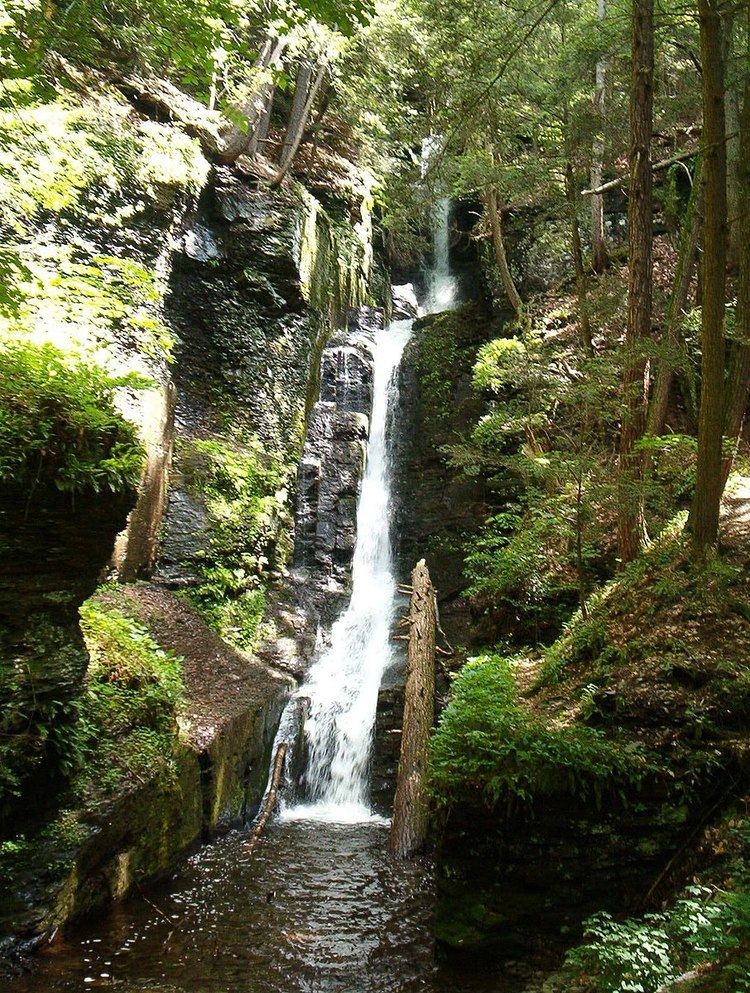Visitors 4,986,700 (in 2011) Phone +1 570-426-2452 | Established September 1, 1965 | |
 | ||
Area 66,741 acres (270.09 km) Address 1978 River Rd, Bushkill, PA 18324, USA Similar Delaware Water Gap, Pocono Mountains, Dingmans Falls, Worthington State Forest, Mount Tammany Profiles | ||
Delaware water gap national recreation area
The Delaware Water Gap National Recreation Area is a 70,000 acres (28,000 ha) protected area designated a National Recreation Area administered by the U.S. Department of the Interior's National Park Service. It is located along the middle section of the Delaware River in New Jersey and Pennsylvania stretching from the Delaware Water Gap northward in New Jersey to the state line near Port Jervis, New York, and in Pennsylvania to the outskirts of Milford. A 40-mile (64 km) section of the Delaware River, entirely within the National Recreation Area, has been granted protected status as the Middle Delaware National Scenic River under the National Wild and Scenic Rivers System and is also administered by the National Park Service. This section of the river is the core of the historical Minisink region.
Contents
- Delaware water gap national recreation area
- Tocks Island Dam and Park creation
- Notable sites within the Park
- References
The Delaware Water Gap National Recreation Area was established in 1978 after the U.S. Army Corps of Engineers transferred condemned lands along the Delaware River to the National Park Service. It scuttled controversial plans to build a hydroelectric dam and reservoir along the Delaware near Tocks Island, approximately 6 miles north of the Delaware Water Gap. This project would have established a large lake 37-mile (60 km) long after flooding the valley. The surrounding land was to be organized as the Tocks Island National Recreation Area. These plans encountered substantial resistance from environmental activists, embittered residents displaced after their property was confiscated by eminent domain, and later by political figures. After the costly Vietnam War, government appropriations for the project dwindled in the face of opposition. In addition, a geological safety assessment revealed the dam would be built too close to nearby active fault lines.
The recreation area includes parts of Sussex and Warren counties in New Jersey, and Monroe, Northampton, and Pike counties in Pennsylvania. The Appalachian Trail runs along much of the eastern boundary of the park and is maintained and updated by the New York - New Jersey Trail Conference. The park offers historical and cultural sites including the Minisink Archaeological Site, Millbrook Village, and the arts center in Peter's Valley and rural scenery approximately an hour's drive from New York City. The park has significant Native American archaeological sites. In addition, a number of structures remain from early Dutch settlement during the colonial period. Outdoor recreational activities include canoeing, hiking, camping, swimming, cycling, cross-country skiing, horseback riding, and picnicking. Fishing and hunting are permitted in season with valid state licenses.
Delaware water gap national recreation area
Tocks Island Dam and Park creation
The Delaware River is prone to floods—some resulting from seasonal snow melt or rain run-off from heavy rainstorms. However, record flooding occurred in August 1955 in the aftermath of two separate hurricanes (Hurricane Connie and Hurricane Diane) that passed over the area within the span of one week. On 19 August 1955, the river gauge at Riegelsville, Pennsylvania recorded that the Delaware River reached a crest of 38.85 feet (11.84 m) above flood stage.
A project to dam the river near Tocks Island was in the works before the 1955 floods. But several deaths and severe damages resulting from these floods brought the issue of flood control to the national level. The U.S. Army Corps of Engineers proposed the construction of the dam, which would have created a 37-mile (60-km) long lake between Pennsylvania and New Jersey, with depths of up to 140 feet. The area around the lake would be established as the Tocks Island National Recreation Area under the oversight of the National Park Service, to offer recreation activities such as hunting, hiking, fishing, and boating. In addition to flood control and recreation, the dam would be used to generate hydroelectric power and provide a clean water supply to New York City and Philadelphia.
Starting in 1960, the present-day area of the Recreation Area was acquired for the Army Corps of Engineers through eminent domain. Approximately 15,000 people were displaced by the condemnation of personal property along the Delaware River and the surrounding area. An estimated 3,000 to 5,000 dwellings and outbuildings were demolished in preparation for the dam project and subsequent flooding of the valley. This included many irreplaceable historical sites and structures connected with the valley's Native American and colonial heritage. The plan was embroiled in controversy and engendered strong opposition by environmental groups and embittered displaced residents.
Because of considerable opposition from environmental activists, the unavailability of government funding, and a geological assessment revealing the dam would be located near active fault lines, the federal government decided to abandon the dam project. It transferred the property to the National Park Service in 1978. The project's land holdings were reorganized to create the Delaware Water Gap National Recreation Area.
